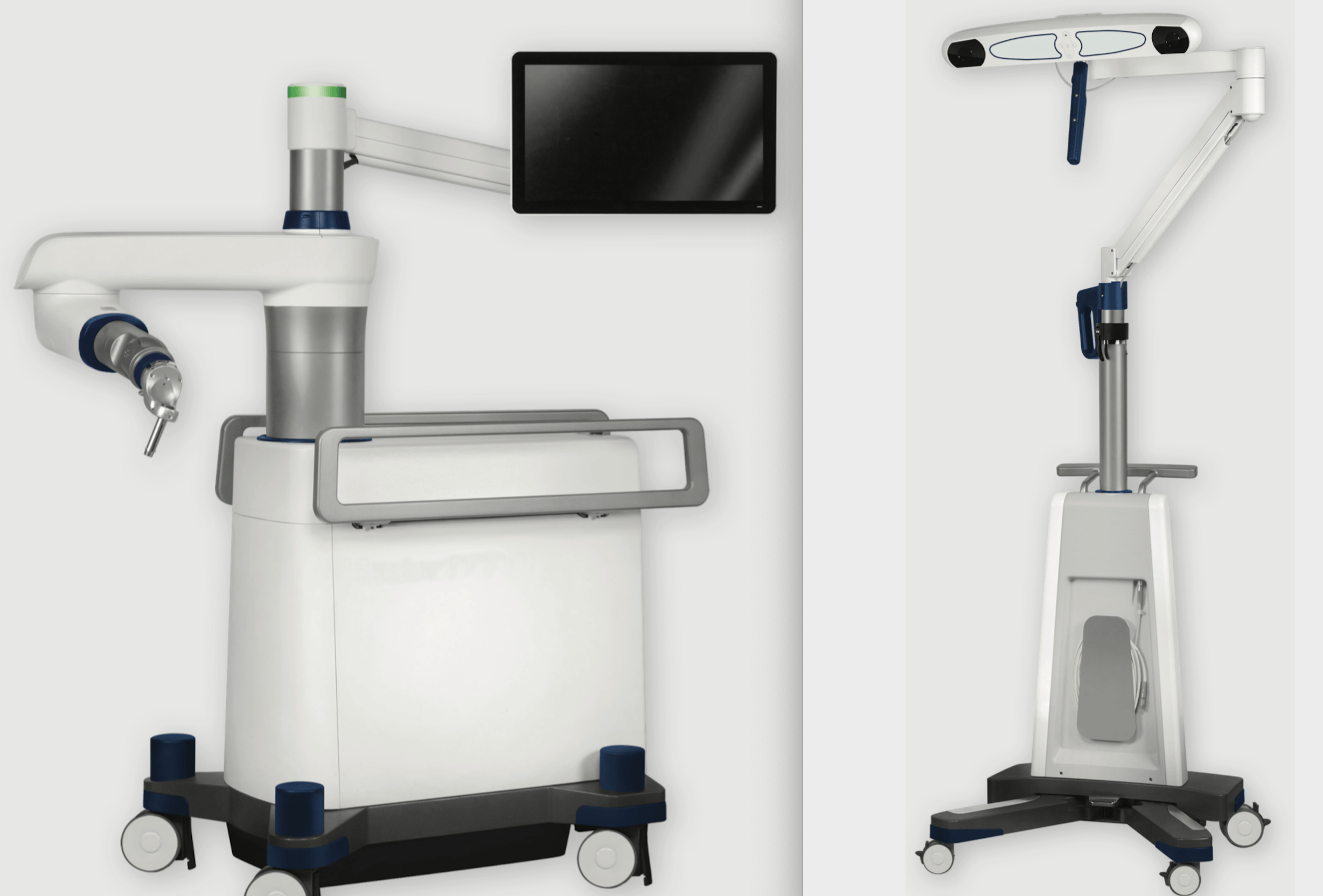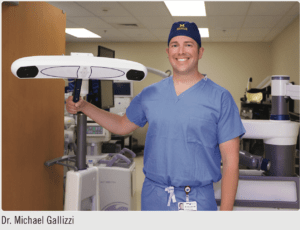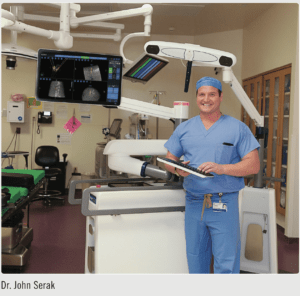GPS TECHNOLOGY GUIDES SURGEONS PERFORMING SPINAL SURGERIES | by

Sky Ridge is First in Colorado with New Robotic Navigation System
Spine surgeries are complex, intricate procedures that demand a lot of surgical precision. Many surgeries require the placement of tiny screws to stabilize the spine and hold the bones together until they fully fuse or heal. Recently, orthopedic and neuro surgeons at Sky Ridge Medical Center became the first in Colorado to use a revolutionary robotic-assisted navigation system to precisely place screws during spine surgery.
“The robotic arm follows the planned surgical route much as your car’s navigation system directs you to where you want to go,” says Michael Gallizzi, MD, a minimally invasive spine surgeon at Sky Ridge.
 Though the device guides placement, it’s the surgeon who selects the screw size and manually inserts the screws. CT scans taken before surgery enable doctors to map out exactly where the screws should go. Surgeons also refer to real-time fluoroscopy (moving X-ray images) throughout the procedure. This approach eases some of the mental and physical strain surgeons may experience when performing multiple spine surgeries in one day.
Though the device guides placement, it’s the surgeon who selects the screw size and manually inserts the screws. CT scans taken before surgery enable doctors to map out exactly where the screws should go. Surgeons also refer to real-time fluoroscopy (moving X-ray images) throughout the procedure. This approach eases some of the mental and physical strain surgeons may experience when performing multiple spine surgeries in one day.
“The robotic guidance tells me precisely where to position the screws through very small incisions,” Gallizzi says. “I don’t have to cut through muscle and tissue to manually feel for the target area as I did in the past.” If the surgeon is off the mark, computer sensors provide immediate feedback allowing for quick adjustments. The smaller incisions promote a less painful, quicker recovery for patients.
In one study, surgeons had 100% accuracy in placing screws using the robotic-assisted spine navigation system compared to 68% accuracy using traditional methods. “Misaligned screws can lead to nerve damage and pain,” Gallizzi says. Rarely, patients require another surgery to remove the screws and receive new ones. Gallizzi’s first surgery using this device was a successful spinal fusion. “I see lots of benefits to using this device for both patients and the surgical team,” he says.
Aside from improving accuracy, the device significantly reduces the amount of radiation exposure to both patients and surgical teams. Depending on the complexity of the surgery, some patients may need up to 100 X-rays before undergoing surgery.
“The robotic guidance tells me precisely where to position the screws through very small incisions. I don’t have to cut through muscle and tissue to manually feel for the target area as I did in the past.”
“When I’m planning for a complicated surgery to correct a severe spine curvature such as one caused by scoliosis, I need images from every angle to help me select the right screw sizes and perform the alignment procedure,” says John Serak, MD, a Sky Ridge neurosurgeon. Serak’s first surgery using the robotic-assisted spine navigation system was on a patient with scoliosis who required 20 screws to keep the spinal adjustments supported and aligned. Even with this high number of screws, the patient required just two pre- surgical X-rays thanks to the enhanced computer technology.
 “With scoliosis, the bones that are stacked on top of each other in the spine twist and turn. This makes it very difficult to get the right trajectory to place screws to correct the curvature,” Serak says. “Thanks to this new technology, I have a very good idea before I go into surgery of what areas may be more troublesome to reach and the best angle to take.”
“With scoliosis, the bones that are stacked on top of each other in the spine twist and turn. This makes it very difficult to get the right trajectory to place screws to correct the curvature,” Serak says. “Thanks to this new technology, I have a very good idea before I go into surgery of what areas may be more troublesome to reach and the best angle to take.”
This pre-surgical information helps speed the entire process. With the robotic-assisted spine navigation system, surgeons like Serak can accurately place a screw in about 3.6 minutes. This is half the amount of time it typically takes to place a screw without computer guidance. As a result, patients spend less time in the operating room and under anesthesia.
Another benefit of the device is its ease of mobility. Similar devices are secured to the surgical table, which means the surgical team can’t move or adjust it once surgery starts. There’s also a slight risk of it being jostled, which would affect accuracy. The system stands on a wheeled floor platform allowing surgeons to move it around the surgical area as needed. Sky Ridge surgeons will use the robotic-assisted spine navigation system for fusion surgeries to help people with degenerative disc disease, scoliosis, spinal instability, spondylolysis and other spinal problems.
Tags: spine surgery
Leave a Comment
Please be respectful while leaving comments. All comments are subject to removal by the moderator.

